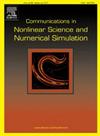天体力学中自旋-自旋问题的动力学
IF 3.4
2区 数学
Q1 MATHEMATICS, APPLIED
Communications in Nonlinear Science and Numerical Simulation
Pub Date : 2024-12-21
DOI:10.1016/j.cnsns.2024.108548
引用次数: 0
摘要
这项工作研究了两个椭球形状的刚体在重力影响下运动的旋转动力学的不同模型。本研究的重点是它们的行为,它们的线性稳定性和主要共振的数值研究。我们假设这两个物体的自旋轴垂直于轨道平面,并与它们最短物理轴的方向一致。在基本的近似中,我们假设质心的轨道是开普勒轨道,我们保留了最低阶的势,根据这个势,两个物体的旋转运动是解耦的,这就是所谓的自旋轨道问题。当考虑势的最高阶近似时,旋转运动变得耦合,从而产生所谓的自旋-自旋问题。最后,我们放弃了开普勒轨道的假设,这意味着旋转动力学与轨道元素的变化是耦合的。由此产生的系统被称为全自旋-自旋问题。我们还在假设一个或两个物体是非刚体的情况下考虑上述模型;耗散效应是由一个旋转速度的线性函数来建模的,它取决于一些耗散系数和漂移系数。本文章由计算机程序翻译,如有差异,请以英文原文为准。
The dynamics of the spin–spin problem in Celestial Mechanics
This work investigates different models of rotational dynamics of two rigid bodies with the shape of an ellipsoid, moving under their gravitational influence. The focus of this study is on their behavior, their linear stability, and numerical investigation of the main resonances. We assume that the spin axes of the two bodies are perpendicular to the orbital plane and coinciding with the direction of their shortest physical axis. In the basic approximation, we assume that the orbits of the centers of mass are Keplerian and we retain the lowest order of the potential, according to which the rotational motions of the two bodies are decoupled, the so-called spin–orbit problem. When considering highest order approximation of the potential, the rotational motions become coupled giving rise to the so-called spin–spin problem. Finally, we release the assumption that the orbit is Keplerian, which implies that the rotational dynamics is coupled to the variation of the orbital elements. The resulting system is called the full spin–spin problem. We also consider the above models under the assumption that one or both bodies are non rigid; the dissipative effect is modeled by a linear function of the rotational velocity, depending on some dissipative and drift coefficients.
We consider three main resonances, namely the (1:1,1:1), (3:2,3:2), (1:1,3:2) resonances and we start by analyzing the linear stability of the equilibria in the conservative and dissipative settings (after averaging and keeping only the resonant angle), showing that the stability depends on the value of the orbital eccentricity. By a numerical integration of the equations of motion, we compare the spin–orbit and spin–spin problems to highlight the influence of the coupling term of the potential in the conservative and dissipative case. We conclude by investigating the effect of the variation of the orbit on the rotational dynamics, showing that higher order resonant islands, that appeared in the Keplerian case, are destroyed in the full problem.
求助全文
通过发布文献求助,成功后即可免费获取论文全文。
去求助
来源期刊

Communications in Nonlinear Science and Numerical Simulation
MATHEMATICS, APPLIED-MATHEMATICS, INTERDISCIPLINARY APPLICATIONS
CiteScore
6.80
自引率
7.70%
发文量
378
审稿时长
78 days
期刊介绍:
The journal publishes original research findings on experimental observation, mathematical modeling, theoretical analysis and numerical simulation, for more accurate description, better prediction or novel application, of nonlinear phenomena in science and engineering. It offers a venue for researchers to make rapid exchange of ideas and techniques in nonlinear science and complexity.
The submission of manuscripts with cross-disciplinary approaches in nonlinear science and complexity is particularly encouraged.
Topics of interest:
Nonlinear differential or delay equations, Lie group analysis and asymptotic methods, Discontinuous systems, Fractals, Fractional calculus and dynamics, Nonlinear effects in quantum mechanics, Nonlinear stochastic processes, Experimental nonlinear science, Time-series and signal analysis, Computational methods and simulations in nonlinear science and engineering, Control of dynamical systems, Synchronization, Lyapunov analysis, High-dimensional chaos and turbulence, Chaos in Hamiltonian systems, Integrable systems and solitons, Collective behavior in many-body systems, Biological physics and networks, Nonlinear mechanical systems, Complex systems and complexity.
No length limitation for contributions is set, but only concisely written manuscripts are published. Brief papers are published on the basis of Rapid Communications. Discussions of previously published papers are welcome.
 求助内容:
求助内容: 应助结果提醒方式:
应助结果提醒方式:


